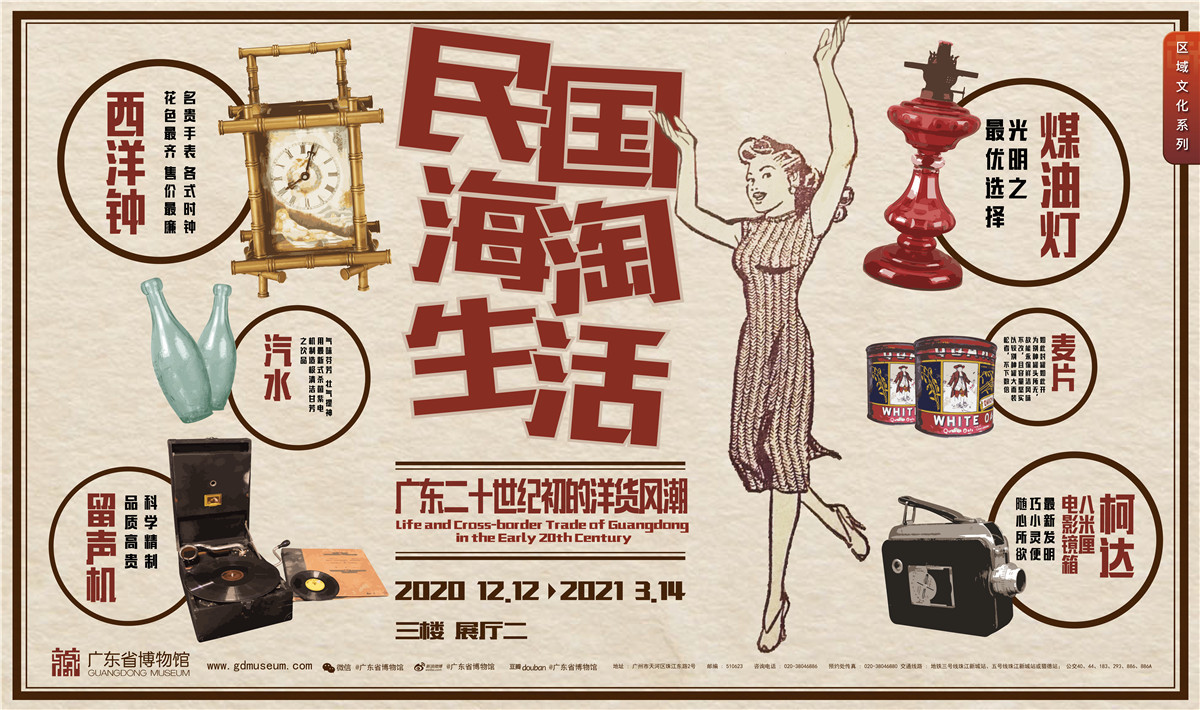
Chinese Reporter: Boey Huang
English Editor: Tom Wan
At the beginning of the 20th century, a radical commercial transformation took place in Guangdong, and the pursuit of foreign goods became the mainstream of people's consumption. The blend and merge of Chinese and foreign products, cultures, values, and life patterns boosted in the Republic of China, and new patterns of clothing, food, housing and transportation emerged. A hundred years ago, foreign trade changed people's lives at that time, while the entry of imported products also promoted the gradual development and growth of national industries.
The Guangdong Museum, located in south China's Guangzhou, is holding an exhibition on "Life and Cross-border Trade of Guangdong in the Early 20th Century." Through its over 300 exhibits, the audience gets to revisit the life under the foreign-goods trend in the Republican period in China's history.

Yan Ruyu was a rich modern lady in the Republic of China, who was born and raised in Guangzhou in the early 20th century when western goods flooded into Chinese market. Western-styled mansions, curly hair, improved cheongsam and western cuisine were just child's play, while traveling with a portable folding camera and watching movies at home with a hand-cranked cinematograph were all the trend. Through our lens, let's take a look at how Yan traveled and lived her exquisite life in China's Republican Era.
Click here to read more about the clothing and food culture in the early 20th century.

Home cinema already?
"Electric fan above and flowery tiles below" is an apt portrayal of the wealthy people's living environment in the Republic of China. The entry of foreign goods and western culture enabled a high degree of integration of East and West in architecture, living space, and furniture, which opened the door to modern life for citizens then.

Yan's family was one of the 50,000 families that could afford electric lights in Guangzhou in the 1920s. European electric fans, Danish telephones and lights brought great convenience to Yan's life. What Yan Ruyu liked most was, in particular, a Kodak 90 hand-cranked movie machine, which allowed her to enjoy the most fashionable form of entertainment of the time -- watching movies at home without having to go out and wait in line for a ticket.

The use of electric lamps also allowed Yan Ruyu to enjoy reading in brighter light, as compared to the traditional kerosene lamp. Interestingly, a blend of East and West was not only manifested in its design and pattern, but also in the materials used to manufacture it. The base of the lamp was made into a traditional Chinese figure with Guangzhou's porcelain, which was exported overseas and later became a part of the lamp, before it was imported into Guangzhou again.

Although electricity had begun to enter Guangzhou's homes in the early years of the Republican Era, people's awareness of the dangers of electricity was yet very limited. Therefore, the power companies then would help educate the public on electricity safety and electric shock rescue measures in addition to providing electricity services.

Early ride-hailing with rickshaws and motor cars

With the rise of online ride-hailing, it has become increasingly convenient for modern people today to travel around. One can hardly imagine that, in fact, Yan was already an adept user of the ride-hailing service back then. In the Republican Era, diverse means of transportation emerged, ranging from traditional man-pulled rickshaws (「黃包車」in Chinese), automobiles to electric boats, as well as the newly-arisen civil aviation industry, which substantially accelerated the pace of life at the time.

Those man-pulled rickshaws, which stopped at a wave of one's hand, were the most popular means of travel in the Republic of China. In old photos of the 1920s and 1930s, those rickshaws could be seen everywhere in the streets of Guangzhou, Shanghai and Hong Kong. Yan, being a pampered daughter in a wealthy family, was no doubt more into cars. Those were early forms of today's taxis in China and served upon reservation. If Yan wanted to use a car, she would need to call the car company a day in advance to make an order, and the next day there will be a driver in front of her door at the designated time to serve. This is arguably pretty similar to today's ride-hailing, one would say.

All such new means of transportation brought great convenience to Yan. When in a good mood, Yan would bring a portable phonograph, which can be disassembled and put in a box and then reassembled to use after reaching the destination. With the phonograph and a Kodak 127 film camera at hand, Yan was able to travel around different places and take photos at scenic spots like people today.

The blend and merge of Chinese and foreign products, cultures and values, and the emergence of new patterns of clothing, food, housing and transportation were significant characteristics of the time. One cannot deny, that it is always eye-opening and fascinating to glance at how people in the past lived and see the connections with today's life.




















Comment